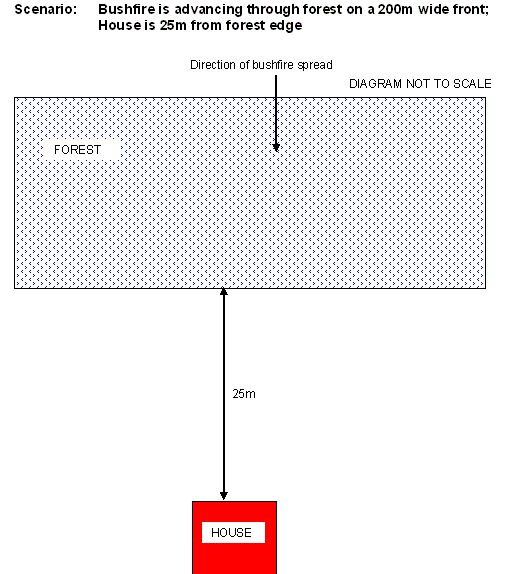
RFS use a 1-in-50 year Fire Danger Index (FDI) of 80. This equates to 40C, 10% RH and 40 kph wind speed at 10 m in the open.
In the following scenario, the terrain is flat.
RFS requires the following designs by law for new developments within the Bushfire Prone Areas of each Municipality.
The key document we are quoting from is “Planning for Bushfire Protection” RFS (2001) – available in published form or on the RFS web site.
The RFS bases its design specs on Australian Standard 3959 and CSIRO research, both of which are guided by McArthur’s theory and use of Byram’s intensity.
RFS identifies that the danger to this house is the vegetation, in this case the forest.
Vegetation in this study is the dry sclerophyll forest. Tables A2.1 and A3.2 present the following “givens” for this forest: fuel load = 25 t / ha, rate of spread = 3.84 kph, Byram’s fire intensity = 48,000 kW / m.
RFS assumes that the forest produces a wall of flame and requires a separation distance between it and the house so that radiation levels on the house will be less than 18 kW / sq m for a level 1 construction design and less than 21 kW / sq m for a level 2 design. The separation distance is called Asset Protection Zone (APZ).
ASSET PROTECTION ZONE (APZ)
The APZ is comprised of two parts, the Outer Protection Area (OPA) and the Inner Protection Area (IPA).
For the forest in this study, the minimum APZ is 40m wide = 10m (OPA) + 30m (IPA) (Refer Table 4.1)
See Diagrams 1 and 2 below for the features of the APZ.
OPA
The stated aims of the OPA are to “substantially decrease the intensity of an approaching fire and reduce the level of direct flame, radiant heat and ember attack on the Inner Protection Area.”
What are the specifications for the OPA?
The RFS document specifies maximum fuel loads for two fuel bed types. If it is a litter bed, the OPA must have no more than 8 t / ha litter fuel. If it is a grass bed, grass height must be below 10cm height.
[There are no specifications for other fuel bed types.]
EXPECTED FIRE BEHAVIOUR IN LITTER FUEL: – 8 t / ha is 0.32 times 25 t / ha, so according to McArthur theory, rate of spread is 0.32 times 3.84kph = 1.22 kph. Therefore, fire intensity = 500 x 8 x 1.22 = 4,880 kW / m.
EXPECTED FIRE BEHAVIOUR IN GRASS FUEL BED: – 10cm height is approx 1 t / ha fuel load. In these weather conditions, the CSIRO Grassland Meter estimates rate of spread of around 14 kph. Therefore, Byram’s fire intensity = 500 x 1x 14 = 7,000 kW / m
IPA
The stated aim of the IPA is to “minimise the impact of direct flame contact and radiant heat” on the house.
What are the specifications for the IPA?
The IPA is 30m wide and is recommended to include a roadway, either a 20m wide road reserve or a 6m wide reserve that includes a 4m wide vehicle trail. The IPA is required to have “minimal fine fuel at ground level”.
EXPECTED FIRE BEHAVIOUR IN LITTER BED: – Let’s say “minimal” means 4 t / ha. This is 0.16 times 25 t / ha, so according to McArthur theory, rate of spread is 0.16 times 3.84kph = 0.61 kph. Therefore, fire intensity = 500 x 4 x 0.61 = 1,220 kW / m
EXPECTED FIRE BEHAVIOUR IN GRASS FUEL BED: – Let’s say “minimal” means 0.5 t / ha. According to the CSIRO Meter, rate of spread stays the same, so therefore, fire intensity = 500 x 0.5 x 14 = 3,500 kW / m.
FUEL-FREE BUFFER? The only indication of a fuel free buffer is the inclusion of a perimeter roadway within the IPA, but there is no prescription about its fuel loading. The stated aims of the roadway are to provide firefighters with access, a safe retreat and a clear control line.
WHAT DO THESE BYRAM INTENSITIES MEAN?
The McArthur Meter formula for flame length suggests that flame length of the forest fire is 30m (Table A3.2), but text A3.2 says that maximum flame length is likely to double this = 60m. This scenario therefore suggests that there will be a wall of flame at the forest edge at least 30m tall. Byram’s intensity at this point is 48,000 kW / m.
Litter bed: – The fire intensity in the 10m wide OPA is 4,880 kW / m. Fire fighters agree this is too high to be controlled. Luke and McArthur say a 6,400 kW / m fire has a flame height of 15m, so at this intensity, we might expect around 10m flame height.
The fire intensity in the IPA is 1,220 kW / m. This is regarded as a controllable fire, provided resources are adequate. Luke and McArthur say a 450kW / m fire has a flame height of 1.2m, so at this intensity, we might expect around 2.5m flame height.
Grass: – The fire intensity in the 10m wide OPA is 7,000 kW / m. Fire fighters believe they can control grass fires up to 10,000 kW / m. Grassland Meter estimates a flame height of approx 1.5m.
The fire intensity in the IPA is 3.500 kW / m. This also is regarded as a controllable fire, provided resources are adequate. Grassland Meter estimates a flame height of approx 0.7m.
WHAT DO THE RFS SEPARATION DISTANCES MEAN?
Table A3.3 defines category of bushfire attack is “within the flame zone” for 20m from the edge of the forest, and “extreme” for up to 30m, and “high” for up to 50m.
The reader should note that (1) the roadway is within the flame zone, which means it cannot be accessed by fire fighters and (2) the house is located at 40m from the edge of the forest which is within the HIGH category. This means a Level 2 level of house construction is required for protection.
CONCLUSION
The house will be subjected to strong radiation from the forest edge fire, but will probably not be damaged by it. But the flame within the IPA, which abuts the house is of much more concern. Flame height in a litter fuel bed could be up to 2.5m and in a grass bed could be up to 0.7m. This means these documented fuel management prescriptions provide the house with zero protection / buffer from flame contact in a severe bushfire.
The RFS document states that embers can cause spotting ahead of the flame, but offers no guidelines for their management within the APZ.
THEREFORE, THESE PRESCRIPTIONS PER SE ARE UNABLE TO PROTECT THE HOUSE IN SEVERE FIRE CONDITIONS, AND THE ONLY CHANCE OF THE HOUSE SURVIVING DEPENDS ON THE PRESENCE AND THE ABILITY OF FIRE FIGHTERS. UNFORTUNATELY, EXPECTED FIRE BEHAVIOUR WITHIN THE IPA IS NOT A SAFE ENVIRONMENT FOR FIRE FIGHTERS.
FURTHERMORE, BECAUSE THE PRESCRIPTIONS IGNORE THE FLAME WITHIN THE IPA, THERE WILL BE FLAME CONTACT ONTO THE HOUSE. THIS MEANS THE LEVEL 2 CONSTRUCTION SPECIFICATION WILL ALSO BE INADEQUATE.
THIS MEANS THE STATED AIMS OF THE OPA, IPA AND PERIMETER ROADWAY CANNOT BE ACHIEVED IN A SEVERE BUSHFIRE.
The reader should note a few key points:
*** These protection prescriptions are required by government legislation in new housing development areas within bushfire prone areas. The major source material for these prescriptions is Australian Standard 3959 and CSIRO research.
*** There is no requirement for existing housing estates. However, if they wish to apply these design criteria, a process now exists whereby approvals can be applied for.
*** The prescriptions are based on the assumption that the forest carries maximum fuel load. There is no option within the prescriptions that allows fire danger to be reduced by managing fuel load in the forest.
